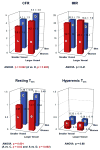Effect of Sex Differences on Invasive Measures of Coronary Microvascular Dysfunction in Patients With Angina in the Absence of Obstructive Coronary Artery Disease
- PMID: 26404195
- PMCID: PMC5292322
- DOI: 10.1016/j.jcin.2015.03.045
Effect of Sex Differences on Invasive Measures of Coronary Microvascular Dysfunction in Patients With Angina in the Absence of Obstructive Coronary Artery Disease
Abstract
Objectives: This study investigated sex differences in coronary flow reserve (CFR) and the index of microcirculatory resistance (IMR) in patients with angina in the absence of obstructive coronary artery disease.
Background: Coronary microvascular dysfunction is associated with worse long-term outcomes, especially in women. Coronary flow reserve (CFR) and the index of microcirculatory resistance (IMR) are 2 methods of assessing the coronary microcirculation.
Methods: We prospectively enrolled 117 women and 40 men with angina in the absence of obstructive coronary artery disease. We performed CFR, IMR, fractional flow reserve, and quantitative coronary angiography in the left anterior descending artery. Coronary flow was assessed with a thermodilution method by obtaining mean transit time (Tmn) (an inverse correlate to absolute flow) at rest and hyperemia.
Results: All patients had minimal atherosclerosis by quantitative coronary angiography (% diameter stenosis: 23.2 ± 12.3%), and epicardial disease was milder in women (fractional flow reserve: 0.88 ± 0.04 vs. 0.87 ± 0.04; p = 0.04). IMR was similar between the sexes (20.7 ± 9.8 vs. 19.1 ± 8.0; p = 0.45), but CFR was lower in women (3.8 ± 1.6 vs. 4.8 ± 1.9; p = 0.004). This was primarily due to a shorter resting Tmn in women (p = 0.005), suggesting increased resting coronary flow, whereas hyperemic Tmn was identical (p = 0.79). In multivariable analysis, female sex was an independent predictor of lower CFR and shorter resting Tmn.
Conclusions: Despite similar microvascular function in women and men by IMR, CFR is lower in women. This discrepancy appears to be due to differences in resting coronary flow between the sexes. The effect of sex differences should be considered in interpretation of physiological indexes using resting coronary flow.
Keywords: coronary flow reserve; coronary microvascular resistance; physiology; sex.
Copyright © 2015 American College of Cardiology Foundation. Published by Elsevier Inc. All rights reserved.
Figures




Comment in
-
Coronary Microvascular Dysfunction: Does Sex Matter?JACC Cardiovasc Interv. 2015 Sep;8(11):1442-1444. doi: 10.1016/j.jcin.2015.04.026. JACC Cardiovasc Interv. 2015. PMID: 26404196 No abstract available.
Similar articles
-
Effect of Sex Difference of Coronary Microvascular Dysfunction on Long-Term Outcomes in Deferred Lesions.JACC Cardiovasc Interv. 2020 Jul 27;13(14):1669-1679. doi: 10.1016/j.jcin.2020.04.002. Epub 2020 Jun 24. JACC Cardiovasc Interv. 2020. PMID: 32593698
-
Preprocedural fractional flow reserve and microvascular resistance predict increased hyperaemic coronary flow after elective percutaneous coronary intervention.Catheter Cardiovasc Interv. 2017 Feb 1;89(2):233-242. doi: 10.1002/ccd.26596. Epub 2016 May 24. Catheter Cardiovasc Interv. 2017. PMID: 27219714
-
Visual Estimates of Coronary Slow Flow Are Not Associated With Invasive Wire-Based Diagnoses of Coronary Microvascular Dysfunction.Circ Cardiovasc Interv. 2024 Jun;17(6):e013902. doi: 10.1161/CIRCINTERVENTIONS.123.013902. Epub 2024 Apr 7. Circ Cardiovasc Interv. 2024. PMID: 38583174 Free PMC article.
-
Invasive assessment of coronary microvascular dysfunction in hypertrophic cardiomyopathy: the index of microvascular resistance.Cardiovasc Revasc Med. 2015 Oct-Nov;16(7):426-8. doi: 10.1016/j.carrev.2015.06.008. Epub 2015 Jul 11. Cardiovasc Revasc Med. 2015. PMID: 26235975 Review.
-
The index of microcirculatory resistance in the physiologic assessment of the coronary microcirculation.Coron Artery Dis. 2015 Aug;26 Suppl 1:e15-26. doi: 10.1097/MCA.0000000000000213. Coron Artery Dis. 2015. PMID: 26247265 Review.
Cited by
-
Standard exercise stress testing attenuates peripheral microvascular function in patients with suspected coronary microvascular dysfunction.BMC Sports Sci Med Rehabil. 2021 Feb 27;13(1):18. doi: 10.1186/s13102-021-00246-8. BMC Sports Sci Med Rehabil. 2021. PMID: 33640014 Free PMC article.
-
Factors Contributing to Coronary Microvascular Dysfunction in Patients with Angina and Non-Obstructive Coronary Artery Disease.J Cardiovasc Dev Dis. 2024 Jul 10;11(7):217. doi: 10.3390/jcdd11070217. J Cardiovasc Dev Dis. 2024. PMID: 39057637 Free PMC article.
-
Role of sex hormones in modulating myocardial perfusion and coronary flow reserve.Eur J Nucl Med Mol Imaging. 2022 Jun;49(7):2209-2218. doi: 10.1007/s00259-022-05675-2. Epub 2022 Jan 13. Eur J Nucl Med Mol Imaging. 2022. PMID: 35024889 Free PMC article.
-
International prospective cohort study of microvascular angina - Rationale and design.Int J Cardiol Heart Vasc. 2020 Sep 11;31:100630. doi: 10.1016/j.ijcha.2020.100630. eCollection 2020 Dec. Int J Cardiol Heart Vasc. 2020. PMID: 32984497 Free PMC article.
-
Comparison of Resting Full-Cycle Ratio and Fractional Flow Reserve in a German Real-World Cohort.Front Cardiovasc Med. 2021 Dec 24;8:744181. doi: 10.3389/fcvm.2021.744181. eCollection 2021. Front Cardiovasc Med. 2021. PMID: 35004875 Free PMC article.
References
-
- Bugiardini R, Bairey Merz CN. Angina with “normal” coronary arteries: a changing philosophy. JAMA. 2005;293:477–84. - PubMed
-
- Daly C, Clemens F, Lopez Sendon JL, et al. Gender differences in the management and clinical outcome of stable angina. Circulation. 2006;113:490–8. - PubMed
-
- Humphries KH, Pu A, Gao M, Carere RG, Pilote L. Angina with “normal” coronary arteries: sex differences in outcomes. Am Heart J. 2008;155:375–81. - PubMed
-
- Reis SE, Holubkov R, Lee JS, et al. Coronary flow velocity response to adenosine characterizes coronary microvascular function in women with chest pain and no obstructive coronary disease: results from the pilot phase of the Women’s Ischemia Syndrome Evaluation (WISE) study. J Am Coll Cardiol. 1999;33:1469–75. - PubMed
-
- Pepine CJ, Anderson RD, Sharaf BL, et al. Coronary microvascular reactivity to adenosine predicts adverse outcome in women evaluated for suspected ischemia: results from the National Heart, Lung and Blood Institute WISE (Women’s Ischemia Syndrome Evaluation) study. J Am Coll Cardiol. 2010;55:2825–32. - PMC - PubMed
Publication types
MeSH terms
Grants and funding
LinkOut - more resources
Full Text Sources
Other Literature Sources
Medical

